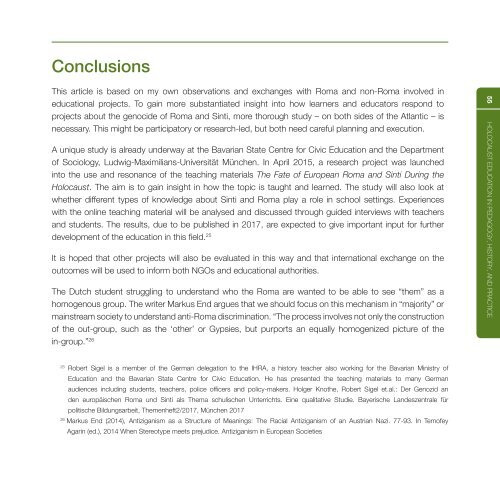2kNreeJ
2kNreeJ
2kNreeJ
You also want an ePaper? Increase the reach of your titles
YUMPU automatically turns print PDFs into web optimized ePapers that Google loves.
Conclusions<br />
This article is based on my own observations and exchanges with Roma and non-Roma involved in<br />
educational projects. To gain more substantiated insight into how learners and educators respond to<br />
projects about the genocide of Roma and Sinti, more thorough study – on both sides of the Atlantic – is<br />
necessary. This might be participatory or research-led, but both need careful planning and execution.<br />
A unique study is already underway at the Bavarian State Centre for Civic Education and the Department<br />
of Sociology, Ludwig-Maximilians-Universität München. In April 2015, a research project was launched<br />
into the use and resonance of the teaching materials The Fate of European Roma and Sinti During the<br />
Holocaust. The aim is to gain insight in how the topic is taught and learned. The study will also look at<br />
whether different types of knowledge about Sinti and Roma play a role in school settings. Experiences<br />
with the online teaching material will be analysed and discussed through guided interviews with teachers<br />
and students. The results, due to be published in 2017, are expected to give important input for further<br />
development of the education in this field. 25<br />
It is hoped that other projects will also be evaluated in this way and that international exchange on the<br />
outcomes will be used to inform both NGOs and educational authorities.<br />
The Dutch student struggling to understand who the Roma are wanted to be able to see “them” as a<br />
homogenous group. The writer Markus End argues that we should focus on this mechanism in “majority” or<br />
mainstream society to understand anti-Roma discrimination. “The process involves not only the construction<br />
of the out-group, such as the ‘other’ or Gypsies, but purports an equally homogenized picture of the<br />
in-group.” 26<br />
55 HOLOCAUST EDUCATION IN PEDAGOGY, HISTORY, AND PRACTICE<br />
25<br />
Robert Sigel is a member of the German delegation to the IHRA, a history teacher also working for the Bavarian Ministry of<br />
Education and the Bavarian State Centre for Civic Education. He has presented the teaching materials to many German<br />
audiences including students, teachers, police officers and policy-makers. Holger Knothe, Robert Sigel et.al.: Der Genozid an<br />
den europäischen Roma und Sinti als Thema schulischen Unterrichts. Eine qualitative Studie. Bayerische Landeszentrale für<br />
politische Bildungsarbeit, Themenheft2/2017, München 2017<br />
26<br />
Markus End (2014), Antiziganism as a Structure of Meanings: The Racial Antiziganism of an Austrian Nazi. 77-93. In Temofey<br />
Agarin (ed.), 2014 When Stereotype meets prejudice. Antiziganism in European Societies


